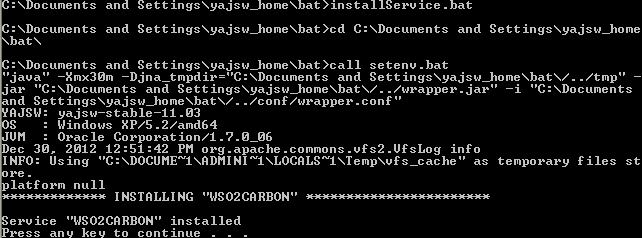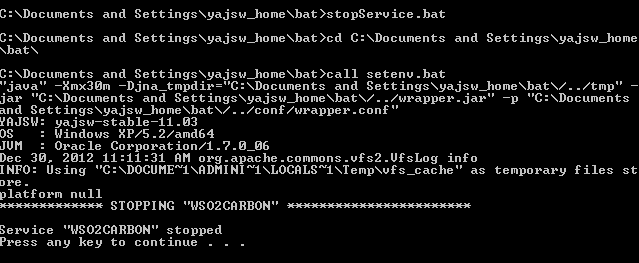Running Streaming Integrator as a Windows Service¶
Note
Before you begin:
- See our compatibility matrix to find out if this version of the product is fully tested on your OS.
Prerequisites¶
- Install JDK and set up the
JAVA_HOMEenvironment variable. - Download and install a service wrapper library to use for running WSO2 API Manager as a Windows service. WSO2 recommends Yet Another Java Service Wrapper ( YAJSW ) versions 11.03 or 12.14, and several WSO2 products provide a default
wrapper.conffile in their<PRODUCT_HOME>/bin/yajsw/directory. The instructions below describe how to set up this file.
Important
Please note that JDK 11 might not be compatible with YAJSW 11.03. Use JDK 8 for YAJSW 11.03 and JDK 11 for YAJSW 12.14.
Setting up the YAJSW wrapper configuration file¶
The configuration file used for wrapping Java Applications by YAJSW is wrapper.conf , which is located in the <YAJSW_HOME>/conf/ directory. The configuration file in <PRODUCT_HOME>/bin/yajsw/ directory of many WSO2 products can be used as a reference for this. Following is the minimal wrapper.conf configuration for running a WSO2 product as a Windows service. Open your wrapper.conf file in <YAJSW_HOME>/conf/ directory, set its properties as follows, and save it.
Info
If you want to set additional properties from an external registry at runtime, store sensitive information like usernames and passwords for connecting to the registry in a properties file and secure it with secure vault.
Note
Manual Configurations
Add the following class path to the wrapper.conf file manually to avoid errors in the WSO2 API Manager Management Console:
wrapper.java.classpath.3 = ${carbon_home}/repository/components/plugins/commons-lang_2.6.0.wso2v1.jar Tip
You may encounter the following issue when starting Windows Services when the file "java" or a "dll" used by Java cannot be found by YAJSW.
"Error 2: The system cannot find the file specified" This can be resolved by providing the "complete java path" for the wrapper.java.command as follows.
wrapper.java.command = ${JAVA_HOME}/bin/javaMinimal wrapper.conf configuration
#********************************************************************
# working directory
#********************************************************************
wrapper.working.dir=${carbon_home}/
# Java Main class.
# YAJSW: default is "org.rzo.yajsw.app.WrapperJVMMain"
# DO NOT SET THIS PROPERTY UNLESS YOU HAVE YOUR OWN IMPLEMENTATION
# wrapper.java.mainclass=
#********************************************************************
# tmp folder
# yajsw creates temporary files named in_.. out_.. err_.. jna..
# per default these are placed in jna.tmpdir.
# jna.tmpdir is set in setenv batch file to <yajsw>/tmp
#********************************************************************
wrapper.tmp.path = ${jna_tmpdir}
#********************************************************************
# Application main class or native executable
# One of the following properties MUST be defined
#********************************************************************
# Java Application main class
wrapper.java.app.mainclass=org.wso2.carbon.bootstrap.Bootstrap
# Log Level for console output. (See docs for log levels)
wrapper.console.loglevel=INFO
# Log file to use for wrapper output logging.
wrapper.logfile=${wrapper_home}\/log\/wrapper.log
# Format of output for the log file. (See docs for formats)
#wrapper.logfile.format=LPTM
# Log Level for log file output. (See docs for log levels)
#wrapper.logfile.loglevel=INFO
# Maximum size that the log file will be allowed to grow to before
# the log is rolled. Size is specified in bytes. The default value
# of 0, disables log rolling by size. May abbreviate with the 'k' (kB) or
# 'm' (mB) suffix. For example: 10m = 10 megabytes.
# If wrapper.logfile does not contain the string ROLLNUM it will be automatically added as suffix of the file name
wrapper.logfile.maxsize=10m
# Maximum number of rolled log files which will be allowed before old
# files are deleted. The default value of 0 implies no limit.
wrapper.logfile.maxfiles=10
# Title to use when running as a console
wrapper.console.title=WSO2 Carbon
#********************************************************************
# Wrapper Windows Service and Posix Daemon Properties
#********************************************************************
# Name of the service
wrapper.ntservice.name=WSO2CARBON
# Display name of the service
wrapper.ntservice.displayname=WSO2 Carbon
# Description of the service
wrapper.ntservice.description=Carbon Kernel
#********************************************************************
# Wrapper System Tray Properties
#********************************************************************
# enable system tray
wrapper.tray = true
# TCP/IP port. If none is defined multicast discovery is used to find the port
# Set the port in case multicast is not possible.
wrapper.tray.port = 15002
#********************************************************************
# Exit Code Properties
# Restart on non zero exit code
#********************************************************************
wrapper.on_exit.0=SHUTDOWN
wrapper.on_exit.default=RESTART
#********************************************************************
# Trigger actions on console output
#********************************************************************
# On Exception show message in system tray
wrapper.filter.trigger.0=Exception
wrapper.filter.script.0=${wrapper_home}/scripts/trayMessage.gv
wrapper.filter.script.0.args=Exception
#********************************************************************
# genConfig: further Properties generated by genConfig
#********************************************************************
placeHolderSoGenPropsComeHere=
wrapper.java.command = java
wrapper.java.classpath.1 = ${carbon_home}/bin/*.jar
wrapper.java.classpath.2 = ${carbon_home}/lib/commons-lang-*.jar
wrapper.java.classpath.3 = ${carbon_home}/lib/*.jar
wrapper.app.parameter.1 = org.wso2.carbon.bootstrap.Bootstrap
wrapper.app.parameter.2 = RUN
wrapper.java.additional.1 = -Xbootclasspath/a:${carbon_home}/lib/xboot/*.jar
wrapper.java.additional.2 = -Xms256m
wrapper.java.additional.3 = -Xmx1024m
wrapper.java.additional.4 = -XX:MaxPermSize=256m
wrapper.java.additional.5 = -XX:+HeapDumpOnOutOfMemoryError
wrapper.java.additional.6 = -XX:HeapDumpPath=${carbon_home}/repository/logs/heap-dump.hprof
wrapper.java.additional.7 = -Dcom.sun.management.jmxremote
wrapper.java.additional.8 = -Dcarbon.registry.root=\/
wrapper.java.additional.9 = -Dcarbon.home=${carbon_home}
wrapper.java.additional.10 = -Dwso2.server.standalone=true
wrapper.java.additional.11 = -Djava.command=${java_home}/bin/java
wrapper.java.additional.12 = -Djava.io.tmpdir=${carbon_home}/tmp
wrapper.java.additional.13 = -Dcatalina.base=${carbon_home}/lib/tomcat
wrapper.java.additional.14 = -Djava.util.logging.config.file=${carbon_home}/repository/conf/etc/logging-bridge.properties
wrapper.java.additional.15 = -Dcarbon.config.dir.path=${carbon_home}/repository/conf
wrapper.java.additional.16 = -Dcarbon.logs.path=${carbon_home}/repository/logs
wrapper.java.additional.17 = -Dcomponents.repo=${carbon_home}/repository/components/plugins
wrapper.java.additional.18 = -Dconf.location=${carbon_home}/repository/conf
wrapper.java.additional.19 = -Dcom.atomikos.icatch.file=${carbon_home}/lib/transactions.properties
wrapper.java.additional.20 = -Dcom.atomikos.icatch.hide_init_file_path=true
wrapper.java.additional.21 = -Dorg.apache.jasper.runtime.BodyContentImpl.LIMIT_BUFFER=true
wrapper.java.additional.22 = -Dcom.sun.jndi.ldap.connect.pool.authentication=simple
wrapper.java.additional.23 = -Dcom.sun.jndi.ldap.connect.pool.timeout=3000
wrapper.java.additional.24 = -Dorg.terracotta.quartz.skipUpdateCheck=true
wrapper.java.additional.25 = -Dorg.apache.jasper.compiler.Parser.STRICT_QUOTE_ESCAPING=false
wrapper.java.additional.26 = -Dfile.encoding=UTF8
wrapper.java.additional.27 = -DworkerNode=false
wrapper.java.additional.28 = -Dhttpclient.hostnameVerifier=DefaultAndLocalhost
wrapper.java.additional.29 = -Dcarbon.new.config.dir.path=${carbon_home}/repository/resources/confSetting up CARBON_HOME¶
Extract WSO2 API Manager that you want to run as a Windows service, and then set the Windows environment variable CARBON_HOME to the extracted product directory location which is for example wso2am-2.1.0 here.
Running the product in console mode¶
You will now verify that YAJSW is configured correctly for running the WSO2 API Manager as a Windows service.
-
Open a Windows command prompt and go to the
<YAJSW_HOME>/bat/directory. For example:cd C:\Documents and Settings\yajsw_home\bat -
Start the wrapper in console mode using the following command:
runConsole.batFor example:

If the configurations are set properly for YAJSW, you will see console output similar to the following and can now access the WSO2 management console from your web browser via https://localhost:9443/carbon.

Working with the WSO2CARBON service¶
To install the Carbon-based product WSO2 API Manager as a Windows service, execute the following command in the <YAJSW_HOME>/bat/ directory:
installService.batThe console will display a message confirming that the WSO2CARBON service was installed.

To start the service, execute the following command in the same console window:
startService.batThe console will display a message confirming that the WSO2CARBON service was started.

To stop the service, execute the following command in the same console window:
stopService.batThe console will display a message confirming that the WSO2CARBON service has stopped.

To uninstall the service, execute the following command in the same console window:
uninstallService.batThe console will display a message confirming that the WSO2CARBON service was removed.
